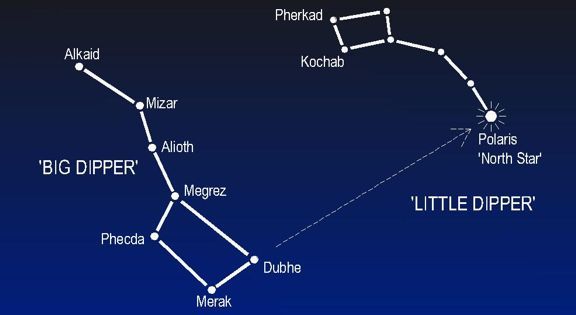Polaris:
Polaris is the one (more or less) fixed point in the skies of the northern hemisphere. It is the star about which all others appear to revolve thanks to the Earth’s daily rotation. Polaris also goes by the North Star, even thought its slightly off the pole by about 1.5 degrees. Fact is because of the wobble in the Earth’s axis, the pole of the sky is slowly moving towards Polaris. This will actually continue until the year 2100 when it will start to pull away.
Polaris has the common reputation of being the brightest star in the sky. In actuality, it’s magnitude of 2.02 brings it in as the 48th brightest star. This low rank is due to the fact that its 430 light years away from the earth. Even though its not brightest star in the sky it’s still easy to find. Simple locate the brighter Big Dipper (Ursa Major) and find the so-called “Pointer” stars in the bowl of the Big Dipper, Dubhe and Merak. Just draw a line, between these two stars and extend it out about 5 times, and you eventually will arrive at Polaris.

.
Polaris Overview:
- Constellation Ursa Minor (Little Dipper)
- Alpha (α) 2h31m, +89°15′
- Type Multiple star
- Magnitude 2.02
- Luminosity 2500 Suns
- Spectral Type F7lb-II
- Distance 430 light years
Ursa Minor Constellation … The Little Bear
Polaris, at the end of Ursa Minor (a.k.a. the Little Dipper), has not always been our North Star … as the north celestial pole has shifted over the centuries. Like a spinning top that wobbles due to a force called torque, our spinning earth is also subject to torque that is caused by the gravitational forces of the sun and moon. As a result the earth’s axis wobbles (called precession), and as a consequence describes a circle in the sky that gradual changes in the direction of the earth’s axis in space.
Nothing is constant … different stars have become the North Star at different times. For example, the star Thuban in the constellation of Draco, the Dragon was the North Star around the year 2600 B.C., during the age of the Pyramid Builders of ancient Egypt. The brightest Guardian, Kochab, was the North Star at the time of Plato, around 400 BC. Into the future around the year 14,000, earth’s axis will point reasonably close to the star Vega, one of the brightest stars in the sky.
Astronomy 101
